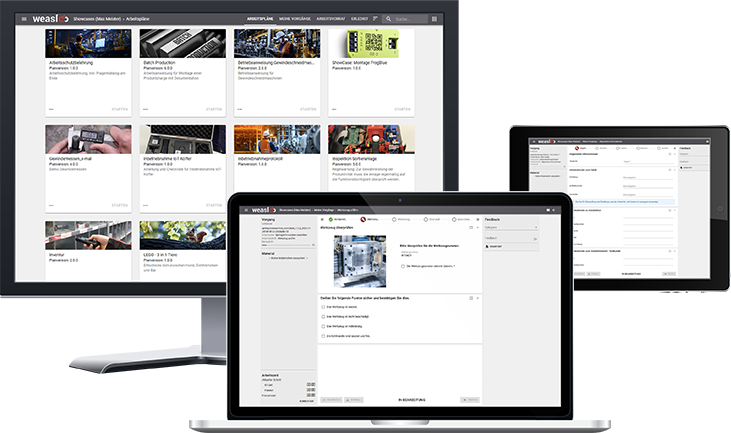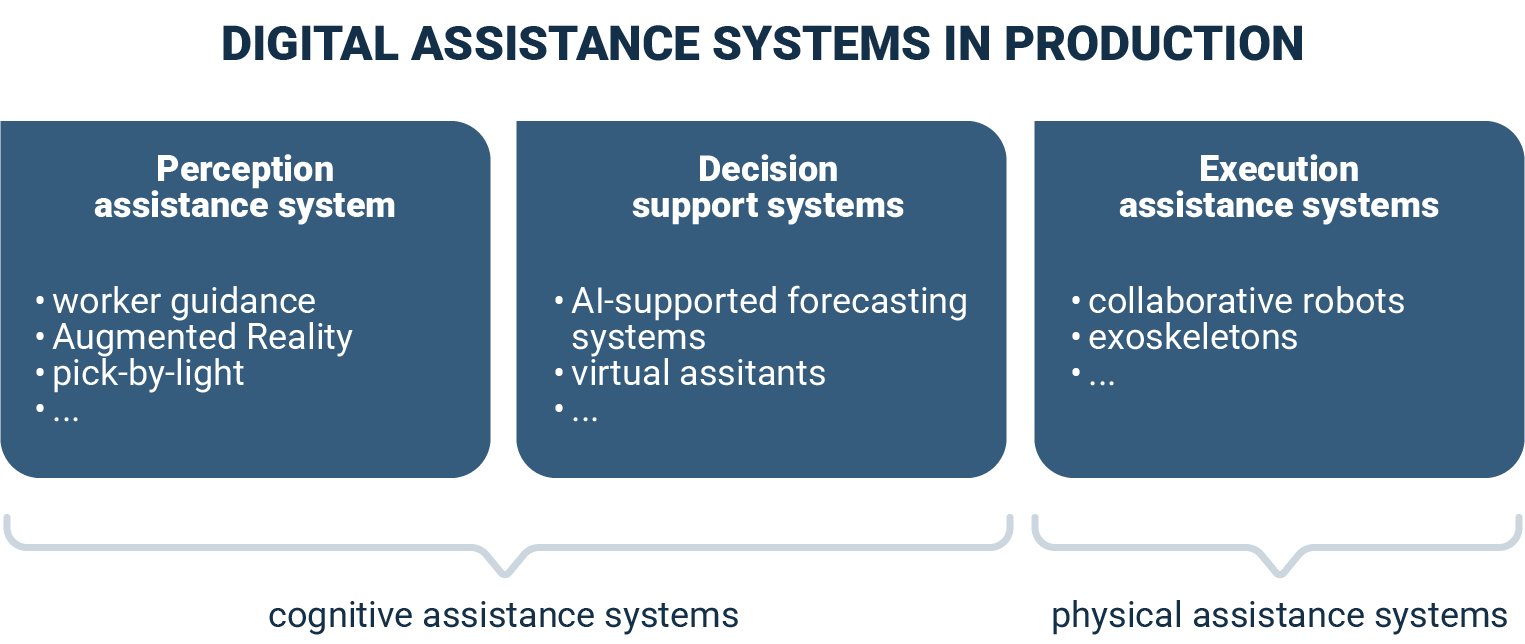Definition: What are digital assistance systems?
Digital assistance systems are software-based solutions that are designed to support people in their (professional or everyday) activities. They provide information and assistance. They are specialized in certain areas of application and can therefore provide very targeted and goal-oriented support.
Some of these systems are purely software solutions that require an end device for use. However, many digital assistance systems are directly linked to specific hardware.
Summary:
- software solutions to support professional or everyday tasks
- can be used as pure software or coupled with special hardware
General examples: What digital assistance systems are there?
Digital assistance systems are as diverse as the areas of application at work and in everyday life. You have probably already seen or used many of them without classifying them in the “digital assistance systems” category.
Driver assistance systems in the car
Almost every car today has some kind of digital assistance system. They start with lane departure warning, continue with emergency braking and cruise control and end with autonomous driving. They all have one thing in common: they support you while driving and usually provide safety-related services.
Sleep trackers & sleep analysis devices
Sleep trackers are designed to monitor and analyze your sleep patterns. Based on the data, you can receive information about the quality of your sleep or even receive warnings in the event of abnormalities. From a global perspective, all fitness trackers and smartwatches are nothing more than digital assistants.
Notification & alarm systems via app
Your smartphone itself is certainly already a kind of digital assistance system. And there are more and more apps on it that take over assistance functions. For example, certain apps can warn you in good time if health or safety-relevant situations occur. In concrete terms, a smartphone app can, for example, detect if you fall and make an emergency call accordingly.
Smart home devices with voice assistance
Many apartments and houses are now smart homes. And it is the digital assistance systems that make these homes smart in the first place. Thermostats automatically create your comfortable temperature, in the evening your light bulb dims down to relaxing lighting and Alexa, Siri and co. remind you of appointments, medication and household tasks or take your shopping list.
Chatbots on websites
On many websites, the consultant has been replaced in the first instance by a chatbot. It can already conduct simple dialogs with users and answer basic questions without losing the valuable time of a specialist advisor. Chatbots provide information around the clock and can be used in multiple languages.
Summary:
- driving assistance systems provide support with lane keeping systems, cruise control or emergency braking functions
- smartwatches and sleep trackers analyze health data and provide information
- smartphone apps warn in an emergency and make an emergency call if necessary
- smart home systems control lighting, temperature and household appliances - also via voice assistant
- chatbots answer frequently asked questions automatically and around the clock
Digital assistance systems in production
We have seen: Digital assistance systems have long been an integral part of everyday life and make your life easier in many ways. But smart helpers are also becoming increasingly important in the production environment. There are numerous reasons for this:
- The demand for customized products is increasing and poses challenges for your employees, their expertise and your company's flexibility.
- Further developments and breakthroughs are occurring almost by the hour. These shortened innovation cycles lead to frequent process changes that you need to manage with confidence.
- The increasing number of variants increases the complexity of production.
To meet these challenges, you need flexible, efficient and error-reducing systems that optimally support your employees. And you've probably already guessed it: digital assistance systems are predestined for this.
Summary:
- efficient process support helps with variant diversity and complex processes
- assistance systems enable rapid response to new requirements
- fewer errors, more productivity, reliable processes
What types of digital assistance systems are there in production?
In production, too, not all assistance systems are the same. In principle, we differentiate between three types of digital systems: perception assistance systems, decision assistance systems and execution assistance systems. What are the differences?
Perception assistance systems
Perception assistance systems support the acquisition of information via the five senses. They are essentially digital software assistance systems, but they require hardware to run. Their aim is to make relevant information more usable in the work process.
Example #1: Worker guidance on mobile devices
A worker guidance system - often also called a worker guidance system - is software for digital step-by-step instructions that can usually be used on stationary computers as well as on tablets and smartphones. It guides employees through assembly, testing or set-up processes, for example.
Example #2: Augmented reality (AR)
With augmented reality, digital content is superimposed on the real world. For example, you can superimpose information onto the worker's field of vision using data goggles to support assembly work, maintenance or quality control.
Example #3: Pick-by-Light
Pick-by-light systems are workstations that consist of hardware and corresponding software. During processing, light signals indicate the correct storage location or container from which the employee must pick the next component.
Decision assistance systems
Decision assistance systems are also essentially digital assistance systems that are executed or represented by hardware. They are designed to support decisions and therefore help with cognitive information processing - especially in problem solving, learning processes and skills development. The functions of a decision assistance system include the preparation of decisions, the prioritization of tasks and data analysis for decision-making.
Example #1: AI-supported forecasting systems
These are applications that can predict future developments based on collected and analyzed data. A practical example: with a predictive maintenance application, you can predict machine failures and ultimately prevent them.
Example #2: virtual assistants
Virtual assistants are also based on a broad database. This makes it possible for the assistant to support employees with complex questions or decision-making processes by providing targeted information.
Execution assistance systems
In contrast to the other two types of production assistance systems, execution assistance systems are initially hardware solutions. They are not digital assistance systems in the true sense of the word, but nevertheless usually require software or digital control.
Execution assistance systems are intended to support employees in the actual execution of activities. They simplify physical processes and contribute to ergonomically optimized work, for example by preventing incorrect posture or reducing physical strain.
Example #1: Cobots (collaborative robots)
Cobots work directly with humans without a separating protective space and support them in physically strenuous or monotonous tasks.
Example #2: Exoskeletons
Exoskeletons are externally worn, mechanical support systems that enclose the body and reinforce, support or enable natural movements. In production, they can make physically demanding work easier or even possible in the first place, or support tasks that require a high degree of precision.
Summary:
- perception assistance systems support information intake
- examples: Worker guidance, AR glasses, pick-by-light.
- decision assistance systems help with analysis and decision-making
- examples: AI forecasts, virtual assistants
- execution assistance systems support physical work
- examples: Cobots, exoskeletons
What advantages do digital assistance systems bring to your production?
The specific benefits of digital assistance systems naturally depend entirely on the type of assistance system. From a higher perspective, however, it can be said that digital assistance systems
- help to ensure occupational safety
- noticeably increase learning productivity through active digital support
- enable faster training and more effective knowledge transfer through digital instructions
- standardize manual activities
- reduce execution errors and increase process reliability
- minimize fluctuations in product quality
- enable more flexible personnel planning
- promote integration and inclusion through skills-based and multilingual content
- support people with disabilities through adaptive systems
- also empower older employees, easily familiarize themselves with new and complex tasks and thus remain able to work for longer
- enable physical relief and simplified operation
- create opportunities for global remote support
- establish technical assistance and training regardless of location
Or to put it in a nutshell: Digital assistance systems help you to secure your competitive advantage in many different ways.
Summary:
- efficiency and quality: faster familiarization, fewer errors, greater process reliability
- flexibility and integration: better personnel planning, multilingual content, inclusion
- relief and support: ergonomic aids, longer working hours, remote support
Rely on an assistance system that adapts to your production
Not every digital assistance system is suitable for every production facility and some systems have high implementation hurdles. Rely on a system that you can start with straight away, that noticeably reduces the workload for your employees and is flexible enough to suit your various objectives. Rely on weasl.
Experience weasl live and see for yourself - with our free showcase environment.


